Environmental Risk Assessment of Polycyclic Aromatic Hydrocarbons in Farmland Soils near Highways: A Case Study of Guangzhou, China
Abstract
:1. Introduction
2. Materials and Methods
2.1. Study Area
2.2. Soil Sampling and Analysis
2.3. Exposure Model
3. Results and Discussion
3.1. PAH Concentrations in Farmland Soil
3.2. Compositional Characteristics of PAHs in Farmland Soils
3.3. Spatial Distribution of PAHs in Farmland Soil
3.4. PAH Concentration in Farmland Soil in Gradient Sampling Area (TB, HL)
3.5. PAH Source Identification
3.6. Pollution Level Assessment of Soil PAHs
3.7. Health Risk Assessment
3.7.1. Toxic Equivalence Concentration
3.7.2. Exposure Model
4. Conclusions
Author Contributions
Funding
Institutional Review Board Statement
Informed Consent Statement
Acknowledgments
Conflicts of Interest
References
- Agarwal, T. Concentration level, pattern and toxic potential of PAHs in traffic soil of Delhi, India. J. Hazard. Mater. 2009, 171, 894–900. [Google Scholar] [CrossRef] [PubMed]
- Suman, S.; Sinha, A.; Tarafdar, A. Polycyclic aromatic hydrocarbons (PAHs) concentration levels, pattern, source identification and soil toxicity assessment in urban traffic soil of Dhanbad, India. Sci. Total Environ. 2016, 545, 353–360. [Google Scholar] [CrossRef] [PubMed]
- Yang, J.; Sun, P.; Zhang, X.; Wei, X.Y.; Huang, Y.P.; Du, W.N.; Qadeer, A.; Liu, M.; Huang, Y. Source apportionment of PAHs in roadside agricultural soils of a megacity using positive matrix factorization receptor model and compound-specific carbon isotope analysis. J. Hazard. Mater. 2021, 403, 123592. [Google Scholar] [CrossRef] [PubMed]
- Ashayeri, N.Y.; Keshavarzi, B. Geochemical characteristics, partitioning, quantitative source apportionment, and ecological and health risk of heavy metals in sediments and water: A case study in Shadegan Wetland, Iran. Mar. Pollut. Bull. 2019, 149, 110495. [Google Scholar] [CrossRef] [PubMed]
- Chen, S.C.; Liao, C.M. Health risk assessment on human exposed to environmental polycyclic aromatic hydrocarbons pollution sources. Sci. Total Environ. 2006, 366, 112–123. [Google Scholar] [CrossRef]
- Pietzsch, R.; Patchineelam, S.R.; Torres, J.P.M. Polycyclic aromatic hydrocarbons in recent sediments from a subtropical estuary in Brazil. Mar. Chem. 2010, 118, 56–66. [Google Scholar] [CrossRef]
- Meng, L.A.; Qiao, M.; Arp, H.P.H. Phytoremediation efficiency of a PAH-contaminated industrial soil using ryegrass, white clover, and celery as mono- and mixed cultures. J. Soils Sediments 2011, 11, 482–490. [Google Scholar] [CrossRef]
- Meyer, T.; Lei, Y.D.; Wania, F. Transport of polycyclic aromatic hydrocarbons and pesticides during snowmelt within an urban watershed. Water Res. 2011, 45, 1147–1156. [Google Scholar] [CrossRef]
- Chen, Y.N.; Zhang, J.Q.; Zhang, F.; Liu, X.P.; Zhou, M. Contamination and health risk assessment of PAHs in farmland soils of the Yinma River Basin, China. Ecotoxicol. Environ. Saf. 2018, 156, 383–390. [Google Scholar] [CrossRef]
- Wild, S.R.; Jones, K.C. Polynuclear Aromatic-Hydrocarbons in the United-Kingdom Environment—A Preliminary Source Inventory and Budget. Environ. Pollut. 1995, 88, 91–108. [Google Scholar] [CrossRef]
- Hu, Y.; Wen, J.Y.; Wang, D.Z.; Du, X.Y.; Li, Y. An interval dynamic multimedia fugacity (IDMF) model for environmental fate of PAHs and their source apportionment in a typical oilfield, China. Chem. Ecol. 2013, 29, 476–488. [Google Scholar] [CrossRef]
- Aichner, B.; Bussian, B.M.; Lehnik-Habrink, P.; Hein, S. Regionalized concentrations and fingerprints of polycyclic aromatic hydrocarbons (PAHs) in German forest soils. Environ. Pollut. 2015, 203, 31–39. [Google Scholar] [CrossRef] [PubMed]
- Wang, C.H.; Wu, S.H.; Zhou, S.L.; Wang, H.; Li, B.J.; Chen, H.; Yu, Y.N.; Shi, Y.X. Polycyclic aromatic hydrocarbons in soils from urban to rural areas in Nanjing: Concentration, source, spatial distribution, and potential human health risk. Sci. Total Environ. 2015, 527, 375–383. [Google Scholar] [CrossRef]
- Pokhrel, B.; Gong, P.; Wang, X.P.; Wang, C.F.; Gao, S.P. Polycyclic aromatic hydrocarbons in the urban atmosphere of Nepal: Distribution, sources, seasonal trends, and cancer risk. Sci. Total Environ. 2018, 618, 1583–1590. [Google Scholar] [CrossRef] [PubMed]
- Liu, S.D.; Xia, X.H.; Yang, L.Y.; Shen, M.H.; Liu, R.M. Polycyclic aromatic hydrocarbons in urban soils of different land uses in Beijing, China: Distribution, sources and their correlation with the city’s urbanization history. J. Hazard. Mater. 2010, 177, 1085–1092. [Google Scholar] [CrossRef]
- Wu, S.H.; Zhou, S.L.; Bao, H.J.; Chen, D.X.; Wang, C.H.; Li, B.J.; Tong, G.J.; Yuan, Y.J.; Xu, B.G. Improving risk management by using the spatial interaction relationship of heavy metals and PAHs in urban soil. J. Hazard. Mater. 2019, 364, 108–116. [Google Scholar] [CrossRef]
- Wang, C.H.; Zhou, S.L.; Song, J.; Tang, J.H.; Wu, S.H. Formation mechanism of soil PAH distribution: High and low urbanization. Geoderma 2020, 367, 114271. [Google Scholar] [CrossRef]
- Zhang, P.; Chen, Y.G. Polycyclic aromatic hydrocarbons contamination in surface soil of China: A review. Sci. Total Environ. 2017, 605, 1011–1020. [Google Scholar] [CrossRef]
- Chen, H.Y.; Teng, Y.G.; Wang, J.S. Source apportionment of polycyclic aromatic hydrocarbons (PAHs) in surface sediments of the Rizhao coastal area (China) using diagnostic ratios and factor analysis with nonnegative constraints. Sci. Total Environ. 2012, 414, 293–300. [Google Scholar] [CrossRef]
- Dudhagara, D.R.; Rajpara, R.K.; Bhatt, J.K.; Gosai, H.B.; Sachaniya, B.K.; Dave, B.P. Distribution, sources and ecological risk assessment of PAHs in historically contaminated surface sediments at Bhavnagar coast, Gujarat, India. Environ. Pollut. 2016, 213, 338–346. [Google Scholar] [CrossRef]
- Seopela, M.P.; McCrindle, R.I.; Combrinck, S.; Augustyn, W. Occurrence, distribution, spatio-temporal variability and source identification of n-alkanes and polycyclic aromatic hydrocarbons in water and sediment from Loskop dam, South Africa. Water Res. 2020, 186, 116350. [Google Scholar] [CrossRef] [PubMed]
- Liu, Y.G.; Gao, P.; Su, J.; da Silva, E.B.; de Oliveira, L.M.; Townsend, T.; Xiang, P.; Ma, L.N.Q. PAHs in urban soils of two Florida cities: Background concentrations, distribution, and sources. Chemosphere 2019, 214, 220–227. [Google Scholar] [CrossRef] [PubMed]
- Amjadian, K.; Sacchi, E.; Mehr, M.R. Heavy metals (HMs) and polycyclic aromatic hydrocarbons (PAHs) in soils of different land uses in Erbil metropolis, Kurdistan Region, Iraq. Environ. Monit. Assess. 2016, 188, 1–16. [Google Scholar] [CrossRef] [PubMed]
- Glaser, B.; Dreyer, A.; Bock, M.; Fiedler, S.; Mehring, M.; Heitmann, T. Source apportionment of organic pollutants of a highway-traffic-influenced urban area in Bayreuth (Germany) using biomarker and stable carbon isotope signatures. Environ. Sci. Technol. 2005, 39, 3911–3917. [Google Scholar] [CrossRef]
- Nikolaeva, O.; Tikhonov, V.; Vecherskii, M.; Kostina, N.; Fedoseeva, E.; Astaikina, A. Ecotoxicological effects of traffic-related pollutants in roadside soils of Moscow. Ecotox. Environ. Saf. 2019, 172, 538–546. [Google Scholar] [CrossRef]
- Gateuille, D.; Evrard, O.; Lefevre, I.; Moreau-Guigon, E.; Alliot, F.; Chevreuil, M.; Mouchel, J.M. Combining measurements and modelling to quantify the contribution of atmospheric fallout, local industry and road traffic to PAH stocks in contrasting catchments. Environ. Pollut. 2014, 189, 152–160. [Google Scholar] [CrossRef]
- Wang, C.H.; Zhou, S.L.; Song, J.; Wu, S.H. Human health risks of polycyclic aromatic hydrocarbons in the urban soils of Nanjing, China. Sci. Total Environ. 2018, 612, 750–757. [Google Scholar] [CrossRef]
- Zhang, Y.; Peng, C.; Guo, Z.H.; Xiao, X.Y.; Xiao, R.Y. Polycyclic aromatic hydrocarbons in urban soils of China: Distribution, influencing factors, health risk and regression prediction. Environ. Pollut. 2019, 254, 112930. [Google Scholar] [CrossRef]
- Qu, Y.J.; Gong, Y.W.; Ma, J.; Wei, H.Y.; Liu, Q.Y.; Liu, L.L.; Wu, H.W.; Yang, S.H.; Chen, Y.X. Potential sources, influencing factors, and health risks of polycyclic aromatic hydrocarbons (PAHs) in the surface soil of urban parks in Beijing, China. Environ. Pollut. 2020, 260, 114016. [Google Scholar] [CrossRef]
- Knafla, A.; Phillipps, K.A.; Brecher, R.W.; Petrovic, S.; Richardson, M. Development of a dermal cancer slope factor for benzo[a]pyrene. Regul. Toxicol. Pharm. 2006, 45, 159–168. [Google Scholar] [CrossRef]
- Peng, C.; Chen, W.P.; Liao, X.L.; Wang, M.E.; Ouyang, Z.Y.; Jiao, W.T.; Bai, Y. Polycyclic aromatic hydrocarbons in urban soils of Beijing: Status, sources, distribution and potential risk. Environ. Pollut. 2011, 159, 802–808. [Google Scholar] [CrossRef]
- Shukla, S.; Khan, R.; Bhattacharya, P.; Devanesan, S.; AlSalhi, M.S. Concentration, source apportionment and potential carcinogenic risks of polycyclic aromatic hydrocarbons (PAHs) in roadside soils. Chemosphere 2022, 292, 133413. [Google Scholar] [CrossRef] [PubMed]
- Wang, X.; Teng, Y.; Ren, W.J.; Han, Y.J.; Wang, X.M.; Li, X.F. Soil bacterial diversity and functionality are driven by plant species for enhancing polycyclic aromatic hydrocarbons dissipation in soils. Sci. Total Environ. 2021, 797, 149204. [Google Scholar] [CrossRef] [PubMed]
- Sanches, S.; Leitao, C.; Penetra, A.; Cardoso, V.V.; Ferreira, E.; Benoliel, M.J.; Crespo, M.T.B.; Pereira, V.J. Direct photolysis of polycyclic aromatic hydrocarbons in drinking water sources. J. Hazard. Mater. 2011, 192, 1458–1465. [Google Scholar] [CrossRef]
- Noro, K.; Yabuki, Y. Photolysis of polycyclic aromatic hydrocarbons adsorbed on polyethylene microplastics. Mar. Pollut. Bull. 2021, 169, 112561. [Google Scholar] [CrossRef] [PubMed]
- Jacobs, L.E.; Weavers, L.K.; Chin, Y.P. Direct and indirect photolysis of polycyclic aromatic hydrocarbons in nitrate-rich surface waters. Environ. Toxicol. Chem. 2008, 27, 1643–1648. [Google Scholar] [CrossRef] [PubMed]
- Nguyen, V.H.; Thi, L.A.P.; Le, Q.V.; Singh, P.; Raizada, P.; Kajitvichyanukul, P. Tailored photocatalysts and revealed reaction pathways for photodegradation of polycyclic aromatic hydrocarbons (PAHs) in water, soil and other sources. Chemosphere 2020, 260, 127529. [Google Scholar] [CrossRef]
- El-Saeid, M.H.; Al-Turki, A.M.; Nadeem, M.E.A.; Hassanin, A.S.; Al-Wabel, M.I. Photolysis degradation of polyaromatic hydrocarbons (PAHs) on surface sandy soil. Environ. Sci. Pollut. Res. 2015, 22, 9603–9616. [Google Scholar] [CrossRef]
- Xu, C.B.; Dong, D.B.; Meng, X.L.; Su, X.; Zheng, X.; Li, Y.Y. Photolysis of polycyclic aromatic hydrocarbons on soil surfaces under UV irradiation. J. Environ. Sci. 2013, 25, 569–575. [Google Scholar] [CrossRef]
- Liang, M.; Liang, H.D.; Rao, Z.; Hong, X.P. Characterization of polycyclic aromatic hydrocarbons in urban-rural integration area soil, North China: Spatial distribution, sources and potential human health risk assessment. Chemosphere 2019, 234, 875–884. [Google Scholar] [CrossRef]
- Wang, J.; Zhang, X.F.; Ling, W.T.; Liu, R.; Liu, J.; Kang, F.X.; Gao, Y.Z. Contamination and health risk assessment of PAHs in soils and crops in industrial areas of the Yangtze River Delta region, China. Chemosphere 2017, 168, 976–987. [Google Scholar] [CrossRef] [PubMed]
- Li, Y.; Long, L.; Ge, J.; Yang, L.X.; Cheng, J.J.; Sun, L.X.; Lu, C.Y.; Yu, X.Y. Presence, distribution and risk assessment of polycyclic aromatic hydrocarbons in rice-wheat continuous cropping soils close to five industrial parks of Suzhou, China. Chemosphere 2017, 184, 753–761. [Google Scholar] [CrossRef] [PubMed]
- Cheng, J.; Yuan, T.; Wu, Q.; Zhao, W.; Xie, H.; Ma, Y.; Ma, J.; Wang, W. PM10-bound polycyclic aromatic hydrocarbons (PAHs) and cancer risk estimation in the atmosphere surrounding an industrial area of Shanghai, China. Water Air Soil Pollut. 2007, 183, 437–446. [Google Scholar] [CrossRef]
- Wu, F.Y.; Tian, K.; Wang, J.F.; Bao, H.Y.; Luo, W.Q.; Zhang, H.; Hong, H.C. Accumulation and translocation of phenanthrene, anthracene and pyrene in winter wheat affected by soil water content. Ecotox. Environ. Saf. 2019, 183, 109567. [Google Scholar] [CrossRef] [PubMed]
- Xiao, R.; Du, X.M.; He, X.Z.; Zhang, Y.J.; Yi, Z.H.; Li, F.S. Vertical distribution of polycyclic aromatic hydrocarbons (PAHs) in Hunpu wastewater-irrigated area in northeast China under different land use patterns. Environ Monit Assess 2008, 142, 23–34. [Google Scholar] [CrossRef]
- Salson, C.; Perrin-Ganier, C.; Schiavon, M.; Morel, J.L. Effect of cropping and tillage on the dissipation of PAH contamination in soil. Environ. Pollut. 2004, 130, 275–285. [Google Scholar] [CrossRef]
- Kumar, V.; Kothiyal, N.C. Distribution behavior and carcinogenic level of some polycyclic aromatic hydrocarbons in roadside soil at major traffic intercepts within a developing city of India. Environ. Monit. Assess. 2012, 184, 6239–6252. [Google Scholar] [CrossRef]
- Van Dolah, R.F.; Riekerk, G.H.M.; Levisen, M.V.; Scott, G.I.; Fulton, M.H.; Bearden, D.; Sivertsen, S.; Chung, K.W.; Sanger, D.M. An evaluation of polycyclic aromatic hydrocarbon (PAH) runoff from highways into estuarine wetlands of South Carolina. Arch. Environ. Con. Tox. 2005, 49, 362–370. [Google Scholar] [CrossRef]
- Kibblewhite, M.G. Contamination of agricultural soil by urban and peri-urban highways: An overlooked priority? Environ. Pollut. 2018, 242, 1331–1336. [Google Scholar] [CrossRef]
- Markiewicz, A.; Bjorklund, K.; Eriksson, E.; Kalmykova, Y.; Stromvall, A.M.; Siopi, A. Emissions of organic pollutants from traffic and roads: Priority pollutants selection and substance flow analysis. Sci. Total Environ. 2017, 580, 1162–1174. [Google Scholar] [CrossRef]
- Werkenthin, M.; Kluge, B.; Wessolek, G. Metals in European roadside soils and soil solution—A review. Environ. Pollut. 2014, 189, 98–110. [Google Scholar] [CrossRef] [PubMed]
- Helmreich, B.; Hilliges, R.; Schriewer, A.; Horn, H. Runoff pollutants of a highly trafficked urban road—Correlation analysis and seasonal influences. Chemosphere 2010, 80, 991–997. [Google Scholar] [CrossRef] [PubMed]
- Kim, S.J.; Park, M.K.; Lee, S.E.; Go, H.J.; Cho, B.C.; Lee, Y.S.; Choi, S.D. Impact of traffic volumes on levels, patterns, and toxicity of polycyclic aromatic hydrocarbons in roadside soils. Environ. Sci. Proc. Impacts 2019, 21, 174–182. [Google Scholar] [CrossRef]
- Christensen, E.R.; Arora, S. Source apportionment of PAHs in sediments using factor analysis by time records: Application to Lake Michigan, USA. Water Res. 2007, 41, 168–176. [Google Scholar] [CrossRef]
- Katsoyiannis, A.; Terzi, E.; Cai, Q.-Y. On the use of PAH molecular diagnostic ratios in sewage sludge for the understanding of the PAH sources. Is this use appropriate.? Chemosphere 2007, 69, 1337–1339. [Google Scholar] [CrossRef] [PubMed]
- Zhang, W.; Zhang, S.C.; Wan, C.; Yue, D.P.; Ye, Y.B.; Wang, X.J. Source diagnostics of polycyclic aromatic hydrocarbons in urban road runoff, dust, rain and canopy throughfall. Environ. Pollut. 2008, 153, 594–601. [Google Scholar] [CrossRef]
- Liu, Y.; Chen, L.; Huang, Q.H.; Li, W.Y.; Tang, Y.J.; Zhao, J.F. Source apportionment of polycyclic aromatic hydrocarbons (PAHs) in surface sediments of the Huangpu River, Shanghai, China. Sci. Total Environ. 2009, 407, 2931–2938. [Google Scholar] [CrossRef]
- Akyuz, M.; Cabuk, H. Gas-particle partitioning and seasonal variation of polycyclic aromatic hydrocarbons in the atmosphere of Zonguldak, Turkey. Sci. Total Environ. 2010, 408, 5550–5558. [Google Scholar] [CrossRef]
- Tobiszewski, M.; Namiesnik, J. PAH diagnostic ratios for the identification of pollution emission sources. Environ. Pollut. 2012, 162, 110–119. [Google Scholar] [CrossRef]
- Maliszewska-Kordybach, B. Polycyclic aromatic hydrocarbons in agricultural soils in Poland: Preliminary proposals for criteria to evaluate the level of soil contamination. Appl. Geochem. 1996, 11, 121–127. [Google Scholar] [CrossRef]
- Bi, X.; Luo, W.; Gao, J.J.; Xu, L.; Guo, J.M.; Zhang, Q.G.; Romesh, K.Y.; Giesy, J.P.; Kang, S.C.; de Boer, J. Polycyclic aromatic hydrocarbons in soils from the Central-Himalaya region: Distribution, sources, and risks to humans and wildlife. Sci. Total Environ. 2016, 556, 12–22. [Google Scholar] [CrossRef] [PubMed]
- Mehr, M.R.; Keshavarzi, B.; Moore, F.; Sacchi, E.; Lahijanzadeh, A.R.; Eydivand, S.; Jaafarzadeh, N.; Naserian, S.; Setti, M.; Rostami, S. Contamination level and human health hazard assessment of heavy metals and polycyclic aromatic hydrocarbons (PAHs) in street dust deposited in Mahshahr, southwest of Iran. Hum. Ecol. Risk Assess. 2016, 22, 1726–1748. [Google Scholar] [CrossRef]
- Jiang, Y.F.; Hu, X.F.; Yves, U.J.; Zhan, H.Y.; Wu, Y.Q. Status, source and health risk assessment of polycyclic aromatic hydrocarbons in street dust of an industrial city, NW China. Ecotox. Environ. Saf. 2014, 106, 11–18. [Google Scholar] [CrossRef] [PubMed]
- Cai, C.Y.; Li, J.Y.; Di, W.; Wang, X.L.; Tsang, D.C.W.; Li, X.D.; Sun, J.T.; Zhu, L.H.; Shen, H.Z.; Tao, S.; et al. Spatial distribution, emission source and health risk of parent PAHs and derivatives in surface soils from the Yangtze River Delta, eastern China. Chemosphere 2017, 178, 301–308. [Google Scholar] [CrossRef] [PubMed]
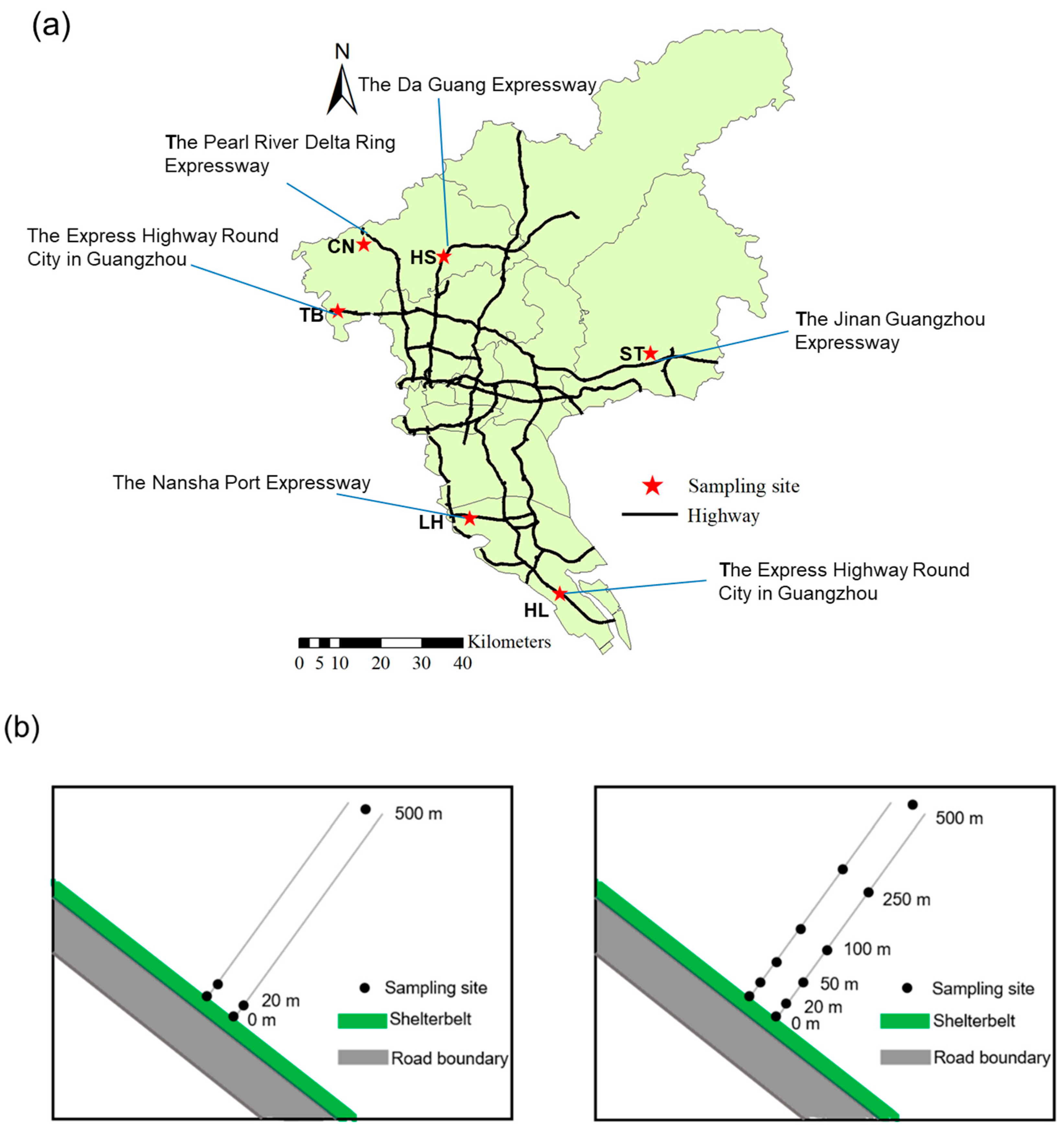
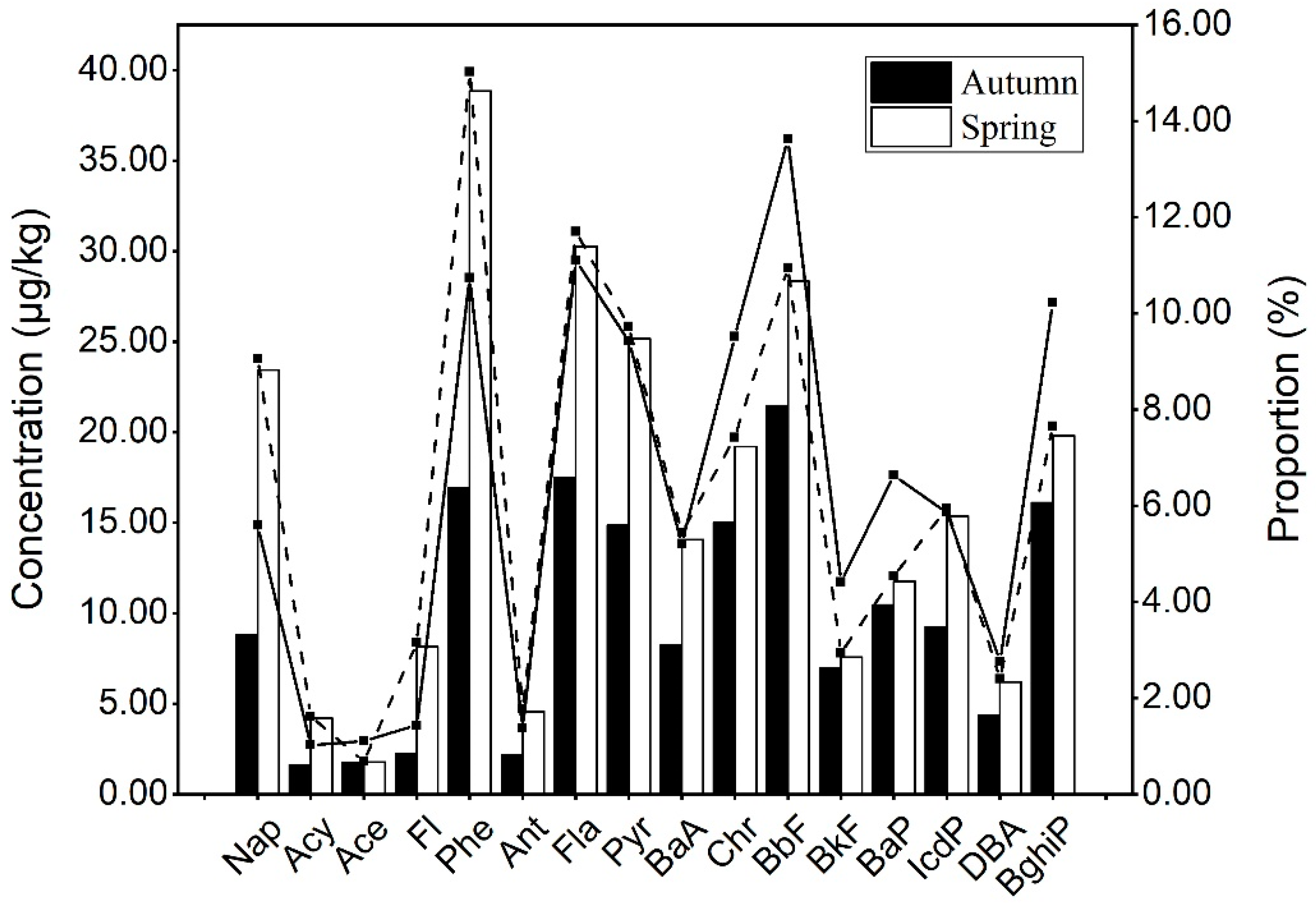
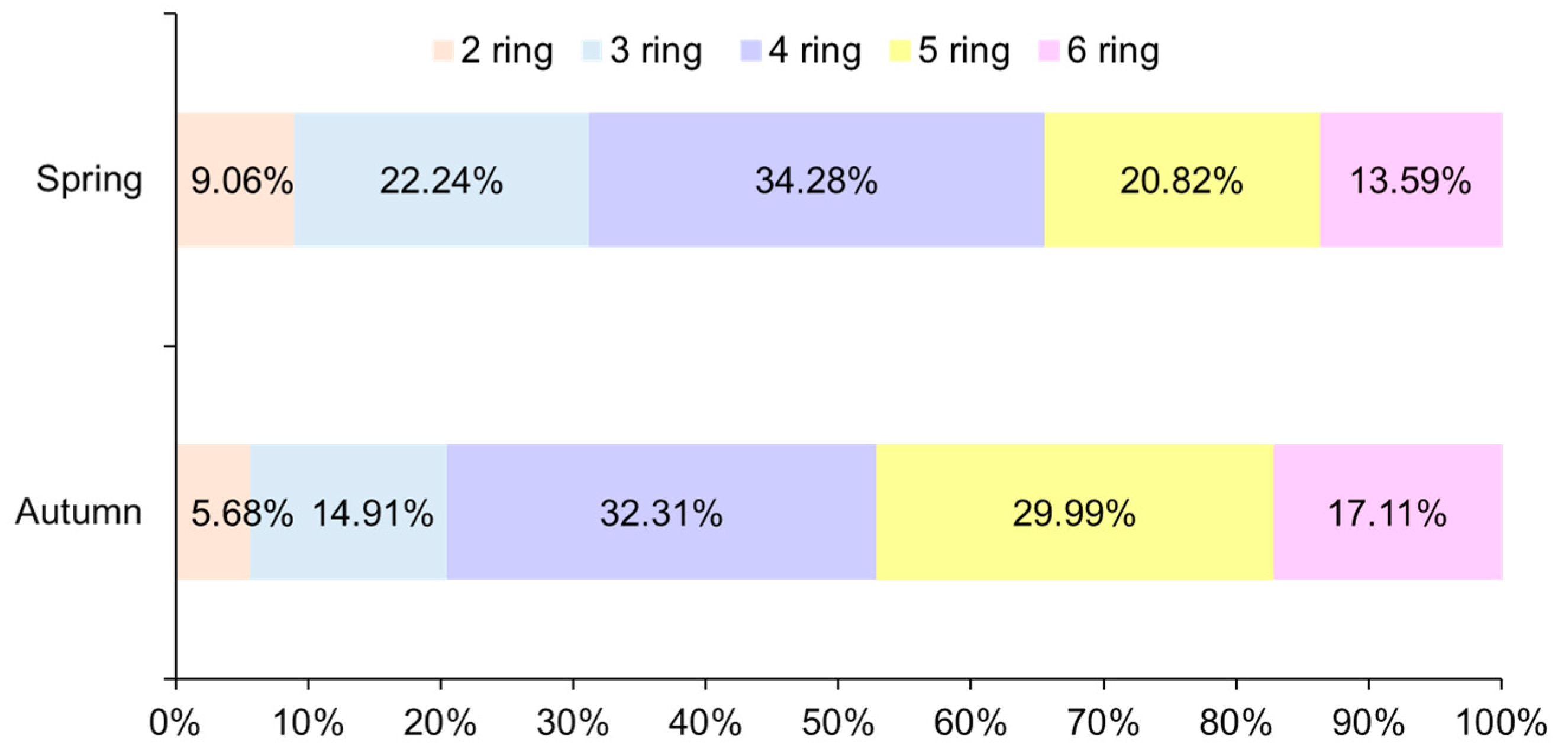
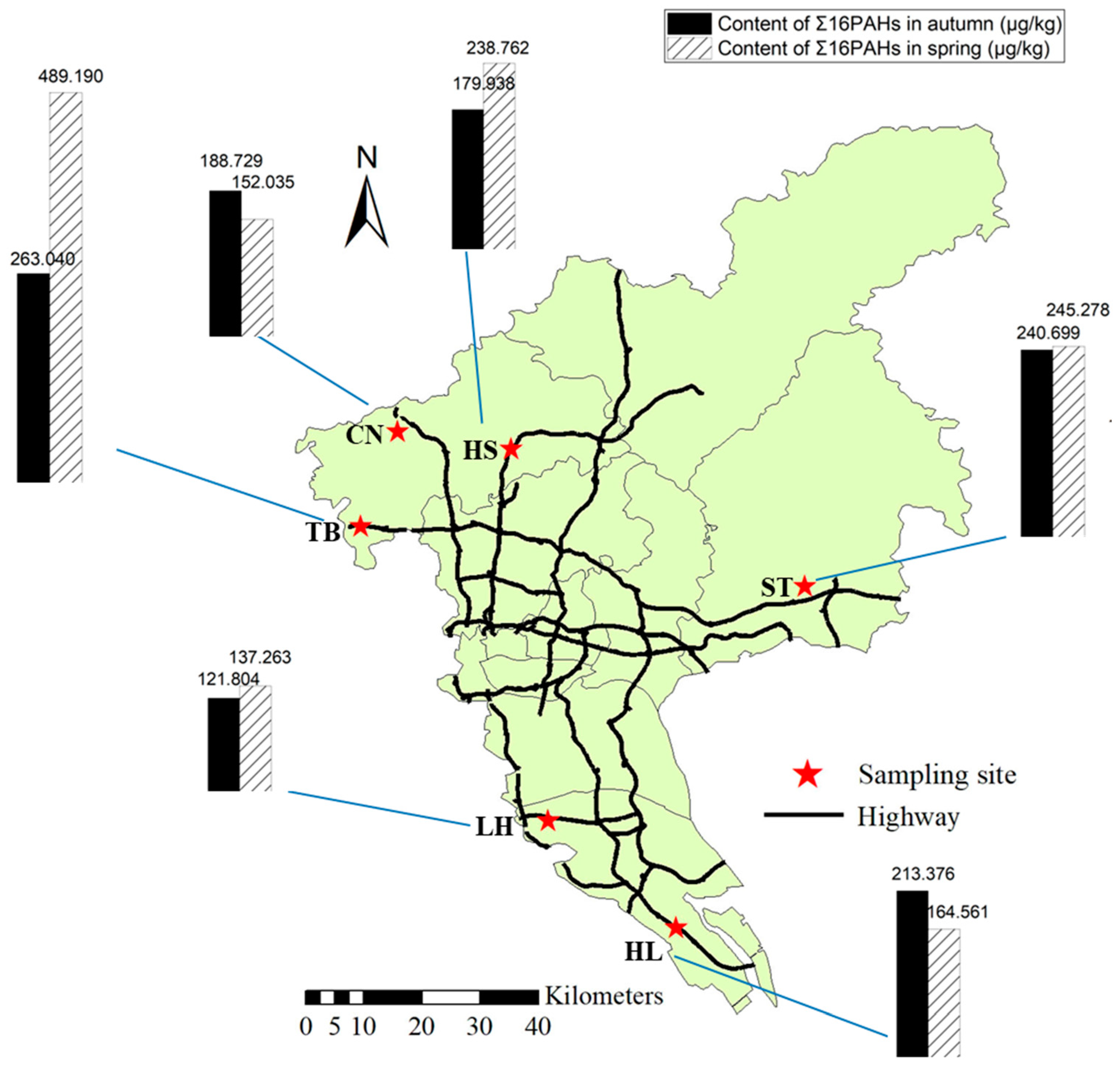

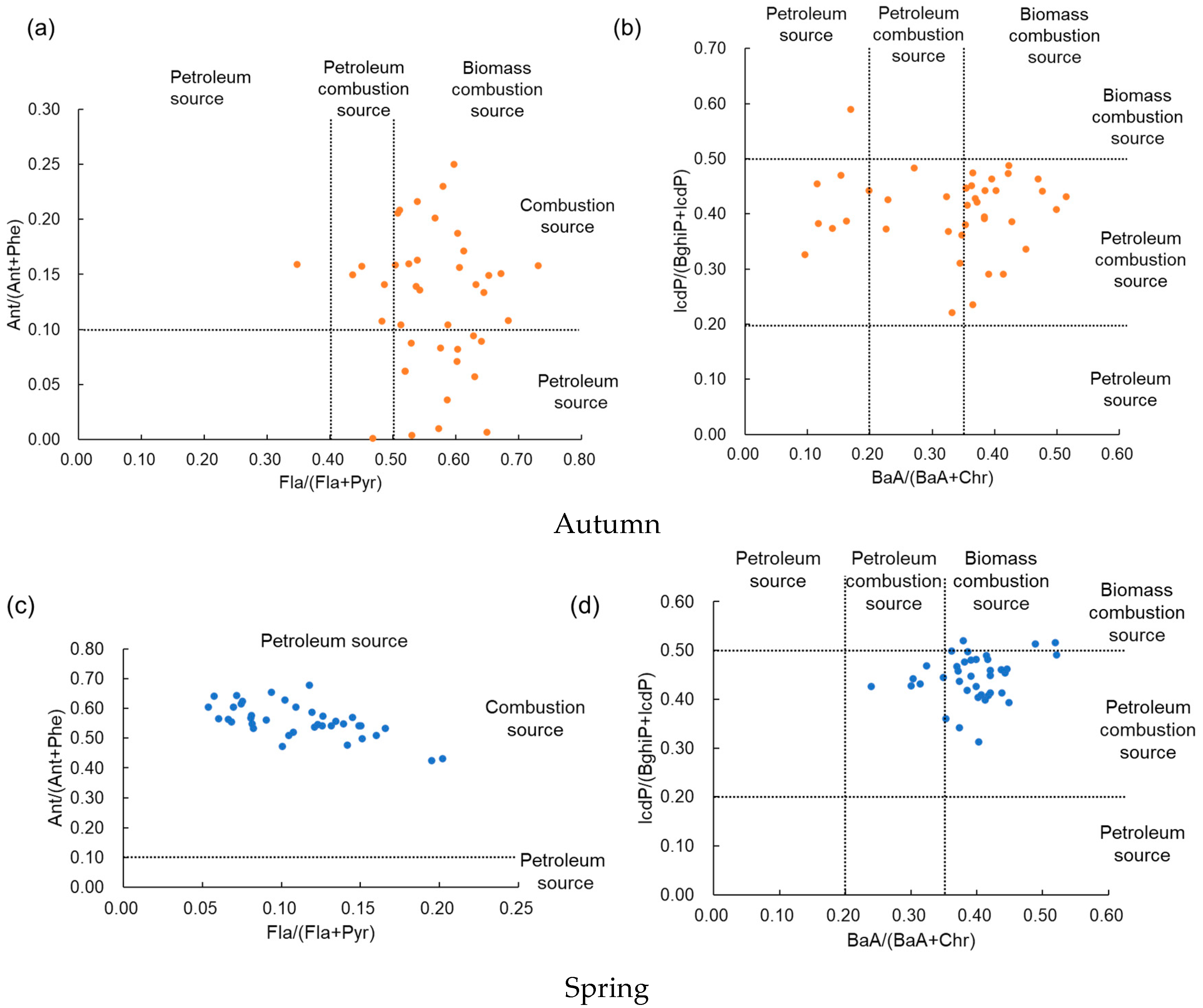
| Sample Serial Number | Location | Date | Number of Samples | Nearby Highway | Road Opening Time |
|---|---|---|---|---|---|
| CN | Chini Town, Huadu District, Guangzhou | October 2020 (Autumn) March 2021 (Spring) | 10 | Pearl River Delta Ring Expressway | December 2014 |
| TB | Tanbu Town, Huadu District, Guangzhou | 22 | Express Highway Round City in Guangzhou | December 2006 | |
| HS | Huashan Town, Huadu District, Guangzhou | 10 | Da Guang Expressway | January 2002 | |
| ST | Shitan Town, Zengcheng District, Guangzhou | 10 | Jinan Guangzhou Expressway | December 2015 | |
| HL | Hengli Town, Nansha District, Guangzhou | 22 | Nansha Port Expressway | December 2004 | |
| LH | Lanhe Town, Nansha District, Guangzhou | 10 | Express Highway Round City in Guangzhou | December 2010 |
| Parameter | Units | Child | Adult | References |
|---|---|---|---|---|
| Body weight (BW) | kg | 6.94 | 58.55 | [32] |
| Exposure frequency (EF) | day year−1 | 350 | 350 | [27] |
| Exposure duration (ED) | year | 6 | 24 | - |
| Inhalation rate | m3 day−1 | 5.65 | 13.04 | [32] |
| Dust ingestion rate | mg day−1 | 200 | 100 | [27] |
| Dermal exposure area (SA) | cm2 day−1 | 2800 | 5700 | [27] |
| Dermal exposure factor (AF) | mg cm−2 | 0.20 | 0.07 | [27] |
| Dermal adsorption factor (ABS) | - | 0.13 | 0.13 | [30] |
| Average lifespan (AT) | day | 81.34 × 365 | 81.34 × 365 | GDASS, 2018 |
| Particle emission factor (PEF) | m3 kg−1 | 1.36 × 109 | 1.36 × 109 | [30] |
| PAHs (μg/kg) | Rings | Autumn | Spring | ||||
|---|---|---|---|---|---|---|---|
| Max | Min | Mean | Max | Min | Mean | ||
| Nap | 2 | 28.954 | 3.897 | 8.799 | 78.143 | 5.667 | 23.423 |
| Acy | 3 | 10.582 | 0.000 | 1.613 | 14.111 | 0.686 | 4.202 |
| Ace | 3 | 6.040 | 0.000 | 1.745 | 4.429 | 0.504 | 1.768 |
| Fl | 3 | 6.653 | 0.357 | 2.249 | 33.545 | 2.049 | 8.148 |
| Phe | 3 | 58.210 | 3.527 | 16.922 | 159.557 | 9.849 | 38.831 |
| Ant | 3 | 5.900 | 0.049 | 2.155 | 12.635 | 1.185 | 4.569 |
| Fla | 4 | 55.711 | 3.709 | 17.464 | 112.717 | 8.021 | 30.243 |
| Pyr | 4 | 49.709 | 2.509 | 14.838 | 98.515 | 8.807 | 25.153 |
| BaA | 4 | 27.773 | 0.674 | 8.214 | 103.496 | 2.742 | 14.068 |
| Chr | 4 | 51.425 | 3.474 | 14.993 | 96.026 | 5.237 | 19.196 |
| BbF | 5 | 77.455 | 5.749 | 21.461 | 96.006 | 7.876 | 28.326 |
| BkF | 5 | 27.223 | 1.102 | 6.952 | 37.626 | 2.195 | 7.568 |
| BaP | 5 | 54.226 | 1.609 | 10.450 | 72.046 | 1.239 | 11.753 |
| DBA | 5 | 25.860 | 0.000 | 4.353 | 22.614 | 0.591 | 6.199 |
| IcdP | 6 | 44.124 | 0.515 | 9.226 | 50.395 | 3.224 | 15.364 |
| BghiP | 6 | 98.010 | 0.358 | 16.097 | 67.904 | 3.953 | 19.792 |
| Σ16PAHs | - | 627.856 | 27.529 | 157.531 | 1059.767 | 63.826 | 258.604 |
| Σ7PAHs | - | 308.086 | 13.122 | 75.648 | 478.210 | 23.105 | 102.475 |
| Level | Total Concentration Range of PAHs | Number of Samples |
|---|---|---|
| Uncontaminated | <200 μg/kg | 25 |
| Weak contamination | 200~600 μg/kg | 17 |
| Contamination | 600~1000 μg/kg | 0 |
| Heavy contamination | >1000 μg/kg | 0 |
| Level | Safe (p ≤ 0.7) | Warning Line (0.7 < p ≤ 1) | Weak Contamination (1 < p ≤ 2) | Contamination (2 < p ≤ 3) | Heavy Contamination (p > 3) |
|---|---|---|---|---|---|
| Number of samples | 42 | 0 | 0 | 0 | 0 |
| PAHs (μg/kg) | TEFs | Min | Max | Mean |
|---|---|---|---|---|
| Nap | 0.001 | 0.007 | 0.044 | 0.016 |
| Acy | 0.001 | 0.001 | 0.007 | 0.003 |
| Ace | 0.001 | 0.000 | 0.005 | 0.002 |
| Fl | 0.001 | 0.001 | 0.017 | 0.005 |
| Phe | 0.001 | 0.091 | 0.831 | 0.277 |
| Ant | 0.010 | 0.001 | 0.007 | 0.003 |
| Fla | 0.001 | 0.010 | 0.065 | 0.024 |
| Pyr | 0.001 | 0.008 | 0.057 | 0.020 |
| BaA | 0.100 | 0.311 | 5.441 | 1.099 |
| Chr | 0.010 | 0.057 | 0.542 | 0.170 |
| BbF | 0.100 | 0.853 | 6.415 | 2.473 |
| BkF | 0.100 | 0.187 | 2.285 | 0.722 |
| BaP | 1.000 | 2.137 | 40.936 | 11.006 |
| IcdP | 0.100 | 0.283 | 3.566 | 1.215 |
| DBA | 1.000 | 1.082 | 18.644 | 5.208 |
| BghiP | 0.010 | 0.039 | 0.521 | 0.177 |
| 16 PAHs | - | 5.068 | 79.380 | 22.420 |
| 7 PAHs | - | 4.910 | 77.828 | 21.894 |
| Exposure Pathway | Children | Adults | ||||
|---|---|---|---|---|---|---|
| Min | Max | Mean | Min | Max | Mean | |
| Dermal contact | 5.370 × 10−5 | 6.030 × 10−4 | 1.906 × 10−4 | 3.693 × 10−5 | 4.147 × 10−4 | 1.311 × 10−4 |
| Ingestion | 4.308 × 10−5 | 4.837 × 10−4 | 1.529 × 10−4 | 2.079 × 10−5 | 2.335 × 10−4 | 7.379 × 10−5 |
| Inhalation | 4.720 × 10−10 | 5.299 × 10−9 | 1.675 × 10−9 | 1.051 × 10−9 | 1.181 × 10−8 | 3.731 × 10−9 |
| Total | 9.678 × 10−5 | 1.087 × 10−3 | 3.435 × 10−4 | 5.772 × 10−5 | 6.482 × 10−4 | 2.049 × 10−4 |
Publisher’s Note: MDPI stays neutral with regard to jurisdictional claims in published maps and institutional affiliations. |
© 2022 by the authors. Licensee MDPI, Basel, Switzerland. This article is an open access article distributed under the terms and conditions of the Creative Commons Attribution (CC BY) license (https://creativecommons.org/licenses/by/4.0/).
Share and Cite
Zhang, X.; Lu, W.; Xu, L.; Wu, W.; Sun, B.; Fan, W.; Zheng, H.; Huang, J. Environmental Risk Assessment of Polycyclic Aromatic Hydrocarbons in Farmland Soils near Highways: A Case Study of Guangzhou, China. Int. J. Environ. Res. Public Health 2022, 19, 10265. https://doi.org/10.3390/ijerph191610265
Zhang X, Lu W, Xu L, Wu W, Sun B, Fan W, Zheng H, Huang J. Environmental Risk Assessment of Polycyclic Aromatic Hydrocarbons in Farmland Soils near Highways: A Case Study of Guangzhou, China. International Journal of Environmental Research and Public Health. 2022; 19(16):10265. https://doi.org/10.3390/ijerph191610265
Chicago/Turabian StyleZhang, Xiaorong, Weiqing Lu, Linyu Xu, Wenhao Wu, Bowen Sun, Wenfeng Fan, Hanzhong Zheng, and Jingjing Huang. 2022. "Environmental Risk Assessment of Polycyclic Aromatic Hydrocarbons in Farmland Soils near Highways: A Case Study of Guangzhou, China" International Journal of Environmental Research and Public Health 19, no. 16: 10265. https://doi.org/10.3390/ijerph191610265
APA StyleZhang, X., Lu, W., Xu, L., Wu, W., Sun, B., Fan, W., Zheng, H., & Huang, J. (2022). Environmental Risk Assessment of Polycyclic Aromatic Hydrocarbons in Farmland Soils near Highways: A Case Study of Guangzhou, China. International Journal of Environmental Research and Public Health, 19(16), 10265. https://doi.org/10.3390/ijerph191610265







